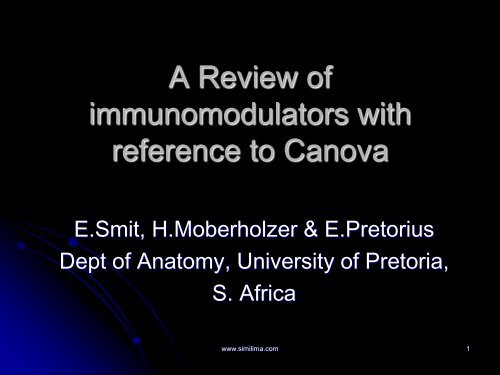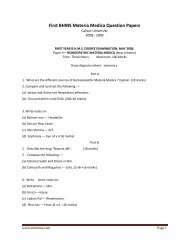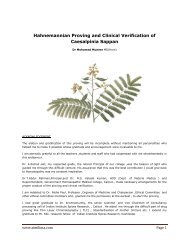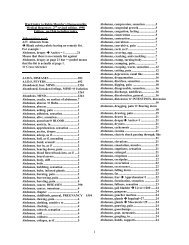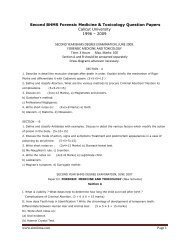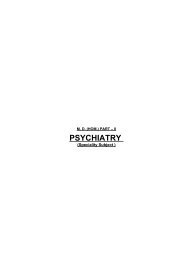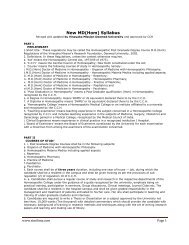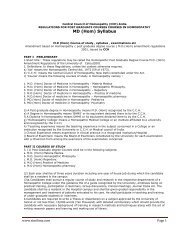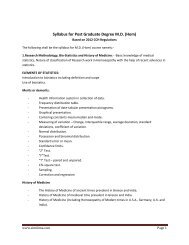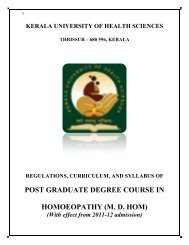A Review of immunomodulators with reference to Canova - Similima
A Review of immunomodulators with reference to Canova - Similima
A Review of immunomodulators with reference to Canova - Similima
Create successful ePaper yourself
Turn your PDF publications into a flip-book with our unique Google optimized e-Paper software.
A <strong>Review</strong> <strong>of</strong><br />
<strong>immunomodula<strong>to</strong>rs</strong> <strong>with</strong><br />
<strong>reference</strong> <strong>to</strong> <strong>Canova</strong><br />
E.Smit, H.Moberholzer & E.Pre<strong>to</strong>rius<br />
Dept <strong>of</strong> Ana<strong>to</strong>my, University <strong>of</strong> Pre<strong>to</strong>ria,<br />
S. Africa<br />
www.similima.com 1
Immunomodla<strong>to</strong>r – Substances which modify the immunity<br />
<strong>of</strong> an individual <strong>to</strong> favour a particular immunological response<br />
<strong>Canova</strong> – A Homoeopathic product produced according <strong>to</strong><br />
Hahnemanian homoeopathic method in Brazil<br />
Its role in Carcinoma, Haema<strong>to</strong>poesis, Macrophage &<br />
Monocyte activation, its ability <strong>to</strong> stabilize platelet morphology<br />
in AIDS is reviewed<br />
www.similima.com 2
Introduction<br />
Immunity is the reaction <strong>of</strong> cells & tissues <strong>to</strong> foreign<br />
substances / Pathogens<br />
Immune response requires timely interplay <strong>of</strong> multiple cell<br />
types <strong>with</strong> in specific microbiological environment <strong>to</strong><br />
maintain immune homeostasis<br />
Innate – First encounter <strong>to</strong> a pathogen ( Inborn)<br />
Contributed by Neutrophil, Monocyte & Macrophage<br />
Adaptive / Acquired – Consequences <strong>of</strong> an initial exposure<br />
( Developed). Contributed by B & T Lymphocytes &<br />
Cy<strong>to</strong>kines<br />
www.similima.com 3
Immunomodula<strong>to</strong>rs – Agents <strong>to</strong> enhance a particular<br />
immunological response available as TLR ( Toll like recep<strong>to</strong>rs),<br />
Cy<strong>to</strong>kines, Cy<strong>to</strong>kine recep<strong>to</strong>rs, Transcription fac<strong>to</strong>r modulation,<br />
Cell surface molecule, T H subset balance, Signalling sequence<br />
& gene activation<br />
1) Specific <strong>to</strong> pathogen – Includes Ab reagents & Vaccines<br />
2) Non specific – Includes Cy<strong>to</strong>kine, Antimicrobial peptide,<br />
Antimicrobial drugs & microbe (Probiotics)<br />
www.similima.com 4
Immune response<br />
Ag presenting cells ( Dendritic cells, Monocytes, Macrophage)<br />
at the site <strong>of</strong> entry <strong>of</strong> microbes ( Skin, GIT, Respi) capture Ag <strong>of</strong><br />
microbe by phagocy<strong>to</strong>sis / pinocy<strong>to</strong>sis<br />
Move <strong>to</strong> T cell rich lymph node <strong>with</strong> the help <strong>of</strong> cy<strong>to</strong>kines<br />
(IL,TNF) produced by sorrounding cells<br />
During migration they mature & start <strong>to</strong> express MHC (Major<br />
his<strong>to</strong>compatibilty complex) which display Ag <strong>to</strong> the cells<br />
www.similima.com 5
� T Lymphocytes (Helper) stimulate B Lymphocytes <strong>to</strong><br />
produce Ab which are recognized by phagocytes<br />
Endocy<strong>to</strong>sis / pinocy<strong>to</strong>sis<br />
Fuses <strong>to</strong> lysosome<br />
Ag are digested by proteolytic enzymes <strong>to</strong> peptides<br />
� Ag recognized by CD8 & T cells Cy<strong>to</strong><strong>to</strong>xic T cells<br />
which kill infected cells <strong>with</strong> foreign Ag<br />
� T cells secrete cy<strong>to</strong>kines when recognizes the co stimula<strong>to</strong>rs<br />
on APC (Ag presenting cells) Proliferation &<br />
differentiation <strong>of</strong> T cells<br />
www.similima.com 6
Human MHC proteins – HLA decided by gene on Chr 6<br />
(A ,B,C – class I DP, PQ, DR – ClassII)<br />
Each bind preferentially <strong>to</strong> different Antigenic peptides<br />
Responsible for Variation in immune responsiveness <strong>to</strong><br />
particular Ag in different individual<br />
www.similima.com 7
TLR ‘s are recognition recep<strong>to</strong>rs that are activated by<br />
specific components, microbes & certain host molecules<br />
13 mamallian TLR’s which can be activated by pathogens<br />
(Exogenous) & immune related (endogenous) are<br />
identified<br />
An Ag when taken up by an APC, the TLR ‘s are stimulated<br />
Increase MHC Ag & cy<strong>to</strong>kine production<br />
Stimulate other APC’s & T & B Lymphocytes<br />
Proper immune response<br />
www.similima.com 8
Immunomodula<strong>to</strong>ry therapies involve one / multiple TLR’s<br />
� Lipid A component <strong>of</strong> lipopolysacharride is a TLR agonist<br />
that induce Th 1 response<br />
� By blocking / stimulating TLR’s, a modification Th1 / Th2<br />
cy<strong>to</strong>kine balance can effect various immunological status<br />
TLR 9 – Allergic disease<br />
CpG – Infectious disease like Hepatitis B, C, Anthrax ,<br />
influenza, Ca, Melanoma<br />
(In combination <strong>with</strong> chemotherapy / adjuvant)<br />
www.similima.com 9
Cy<strong>to</strong>kines are diverse family <strong>of</strong> polypeptide hormone & growth<br />
fac<strong>to</strong>r that regulate many cellular processes produced by<br />
variety <strong>of</strong> immune cells <strong>to</strong> communicate & orchestrate an<br />
immune attack<br />
Modulation <strong>of</strong> cy<strong>to</strong>kine secretion may <strong>of</strong>fer novel approaches<br />
in treatment <strong>of</strong> various diseases<br />
Done by implementation <strong>of</strong> antiinflamma<strong>to</strong>ry cy<strong>to</strong>kines<br />
(IF,IL 4,GF) / neutralizing proinflamma<strong>to</strong>ry cy<strong>to</strong>kines ( IL 2, IF<br />
gamma, TNF)<br />
IL - Used in treatment <strong>of</strong> RA ( Prevents interaction <strong>of</strong> IL1 <strong>to</strong> its<br />
cell surface recep<strong>to</strong>rs)<br />
TNF – RA, Crohn’s disease, Psoriasis ( AI )<br />
INF alpha – advanced melanoma<br />
www.similima.com 10
One <strong>of</strong> the key concept <strong>of</strong> homoeopathy is stimulation <strong>of</strong><br />
body’s defense mechanisms in the process <strong>to</strong> prevent / treat<br />
illness<br />
In the process <strong>of</strong> succussion there is an antigenic imprinting <strong>of</strong><br />
the crystalline lattice <strong>of</strong> water even though no single molecule /<br />
molecular remnant <strong>of</strong> <strong>of</strong> original substance is present<br />
www.similima.com 11
CANOVA is a homoeopathic product developed & produced<br />
according <strong>to</strong> Hahnemanian method as a homoeopathic<br />
remedy in Brazil<br />
Contains –Thuja, Bryonia, Aconite, Arsenic Alb & Lachesis<br />
No <strong>to</strong>xicity / mutagenic effects have been reported<br />
Available as drops in concentration ranging from 4% <strong>to</strong> 50%<br />
50ml contains 49.965ml water & 0.035ml alcohol<br />
Researchers have found that it stimulates host defense in<br />
pathological states<br />
www.similima.com 12
Invitro study <strong>of</strong> canova on BM cells showed activation<br />
Invivo & invitro study <strong>with</strong> canova showed activation <strong>of</strong><br />
macrophages, enhanced spreading <strong>of</strong> cells & formation <strong>of</strong><br />
microvillous extrusions<br />
Activation <strong>of</strong> Monocytes, differentiation <strong>to</strong> macrophages <strong>with</strong><br />
increased expression <strong>of</strong> CD8<br />
Like cy<strong>to</strong>kine, <strong>Canova</strong> induces differentiation <strong>of</strong> monocytes<br />
immunomodula<strong>to</strong>ry activity<br />
www.similima.com 13
In sarcoma - <strong>Canova</strong> treated mice showed delay in<br />
development & reduction in size <strong>of</strong> the tumor, increased<br />
infiltration <strong>of</strong> lymphoid cells, GT & fibrosis sorrounding the<br />
tumor, Leucocy<strong>to</strong>sis & Lymphocy<strong>to</strong>sis ( enhanced immune<br />
response) compared <strong>to</strong> control group<br />
Macrophages showed 86% activation in <strong>Canova</strong> treated & 15%<br />
activation in control<br />
TNF alpha production was decreased while IL2 & IFN gamma<br />
revealed no difference <strong>with</strong> control group<br />
www.similima.com 14
Leishmania – Reduced infection & decreased parasite load in<br />
regional LN & spleen (in vivo)<br />
<strong>Canova</strong> caused indirect proliferation <strong>of</strong> lymphocytes<br />
(Thro’activated macrophages)<br />
Increases Leucocytes, number <strong>of</strong> CD4 T lymphocytes, NK<br />
cells in peripheral blood<br />
Increase in no. <strong>of</strong> adherent, larger & activated cells in canova<br />
treated group.<br />
HIV – Less morphological changes in platelet, less pronounced<br />
membrane blebbing ( prevents thrombocy<strong>to</strong>penia)<br />
Protects membranes <strong>of</strong> platelets & thereby immune system by<br />
protecting ultrastructure<br />
www.similima.com 15
Conclusion<br />
<strong>Canova</strong> is a complex homoeopathic remedy used as<br />
immunomodula<strong>to</strong>r<br />
It activates macrophages, stimulates differentiation &<br />
modulates other inflamma<strong>to</strong>ry process<br />
More research is needed <strong>to</strong> expand the possible uses &<br />
application <strong>of</strong> homoeopathic immunomodula<strong>to</strong>r<br />
www.similima.com 16
Immunomodula<strong>to</strong>rs<br />
Homoeopathic medicines act by immunomodulating ?.......<br />
Homoeopathic medicine given in other countries<br />
Only succussions - Homoeopathic preparation<br />
Different dilutions – 4%, 50% etc<br />
Mixing – Should we try?<br />
www.similima.com 17
www.similima.com 18


